
- CV Examples
- CV Templates
- Cover Letter
- Job Interview
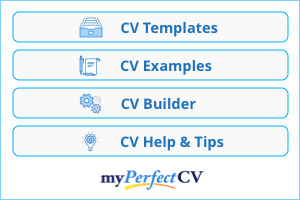

Email Cover Letter and CV | Sending Tips and Examples

What is an email cover letter?
An email cover letter is essentially a job application email through which you apply for a job. The email must contain your cover letter, either in the body of the email or as an attachment, and your CV as a separate attachment.
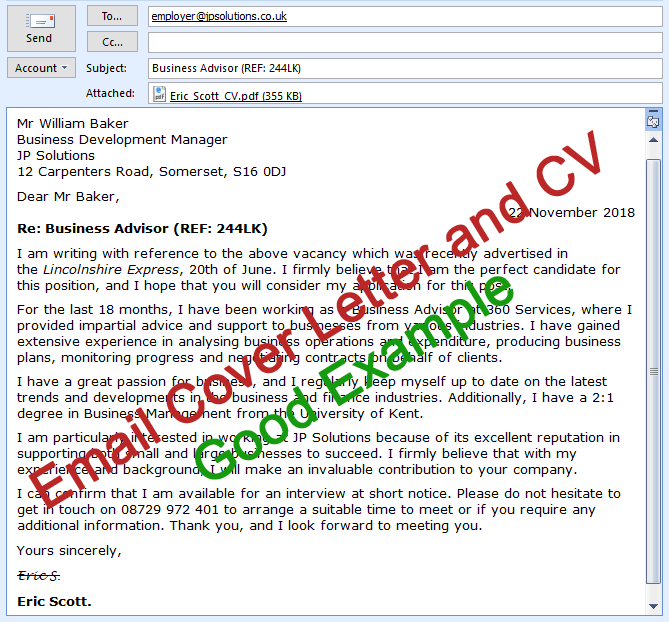
Do you need to send your CV and cover letter via Email?
With the massive technological boom over the past decade, we have seen the dramatic rise in email applications. Sending an email is free, it doesn’t require a stamp, visit the post office or a trip to the company you’re applying for. It all happens within seconds and with just one click of a button.
There are two main reasons why you would send an email to a recruiter:
- When you’re applying for a job
- When you’re enquiring about job opportunities at their company
In this guide, we will mainly focus on applying for jobs that have already been advertised . However, read on as there are also tons of tips and examples for those who wish to inquire about job opportunities via email.
The format of an email cover letter + template
The format of an email cover letter slightly varies from the format of a standard cover letter. For example, there is no need to include your personal details such as name and address on the right side of the letter because your attached CV will already contain all this information. Moreover, it will take up valuable space.
Your email to the recruiter should be in the following format:
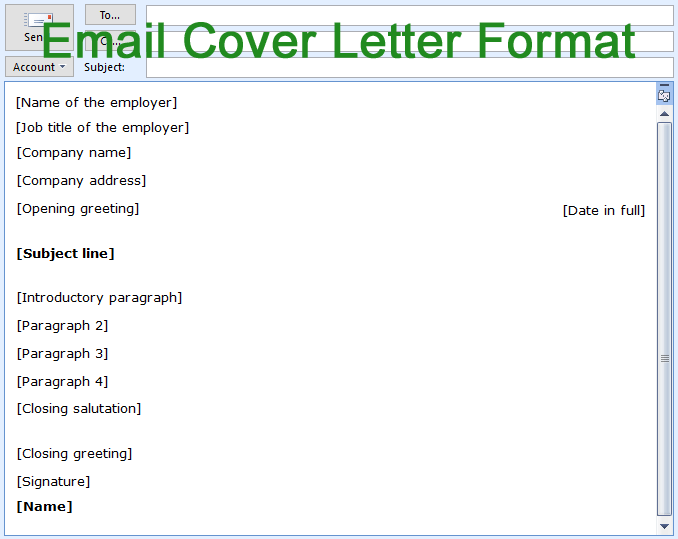
Click here to download this template.
Before you start…
1. Have your perfect CV and cover letter ready
Before working on drafting your email, make sure that you have already written and prepared your CV and cover letter. Check out How to write a Cover Letter and How to write a CV guides for more tips and examples.
2. Be formal
The job application process is a formal process. As such, you have to have a formal approach to writing your email job application.
- Don’t use contractions (e.g. I’m instead of ‘ I am ‘ or Let’s instead of ‘ Let us ‘)
- Write in complete sentences
- Write in paragraphs (not in short lines, as you would in text messaging)
- Use formal greeting (use ‘ Dear Sir/Madam ‘, ‘ Dear [Surname], ‘ or ‘ To whom it may concern ‘ rather than ‘ Hey ‘, ‘ Hi ‘, or ‘ What’s up? ‘)
- Don’t write in capitals (IT’S NOT NICE TO READ TEXT IN CAPITALS!)
You can find more information on formal writing here .
3. Use a professional email address
You must use a professional email address when contacting the recruiter.
It should be:
- It should be short in length
- It should contain your name
- It shouldn’t contain any/many numbers
Acceptable examples:
- [email protected]
Unacceptable examples:
4. Keep it short and to the point
You only have one chance to grab the attention of the prospective employer, so keep the letter short and to the point. Employers only tend to scan CVs and cover letters for less than a minute. Anything longer than a single side of A4 will most likely not be read or considered. Why take the chance? You will have plenty more opportunities in the later stages of the recruitment process, including during the job interview, to fully impress the prospective employer.
5. Write the content of the email in a separate document first
It is highly recommended to write your letter in a separate Word document first rather than typing it up on the actual email client in one go. This is because there will be a smaller chance of losing your work because of the loss of internet connection or the software crashing in the middle of writing your letter.
It also gives you additional time to properly check your written document for grammar and spelling mistakes.
How to send a cover letter and CV via email
Let’s get started…
1. Email subject line for job application
The subject of your email should be the job position followed by the job ID or job reference number:
- IT Manager (ID: W124)
- Receptionist (Job Ref. A2014)
- Cleaner (Job ID: AFT2421)
That’s all that is required.
If you decide to add anything extra, e.g. including your name or a short message, please keep it short as there is a limit on how much of the subject line will be shown to the recruiter when they receive it in their inbox.
Do not write your subject line in capital letters
Some applicants, in a desperate attempt to make their email stand out from the rest, write the subject line of their emails in capital letters, like this:
This is not recommended for two reasons:
- It is awful to read, and;
- You come over as either too desperate or too aggressive. In the worst case scenario, you come over as both.
QUESTION: Should you write the cover letter in the body of the email or send it as an attachment?
Some employers prefer attachments, whereas others prefer the letter in the body of the email. Please check for company requirements on the job advertisement. If the company has not specified their preference, it is up to you how you’d like to send your cover letter to them.
It’s decision time!
As previously stated, there are two acceptable ways of doing this:
1. Include the cover letter as an attached file
If you decide to attach your cover letter separately to the email, always write a short message in the body of the email introducing yourself and giving the reason for emailing the recruiter – don’t leave it blank! The content of your email body should be short, informative and to the point:
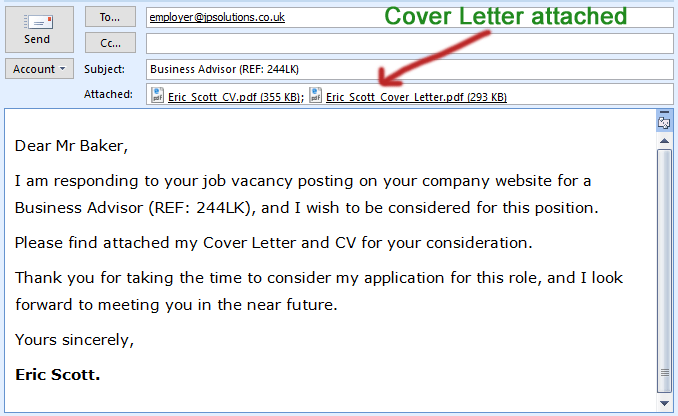
Another good example:
Please find attached my CV and Cover Letter for the position of Senior Research Fellow.
I look forward to hearing from you!
Kind regards, Michael Harper.
2. Write the cover letter in the body of the email
This is the most popular way of sending an email job application.
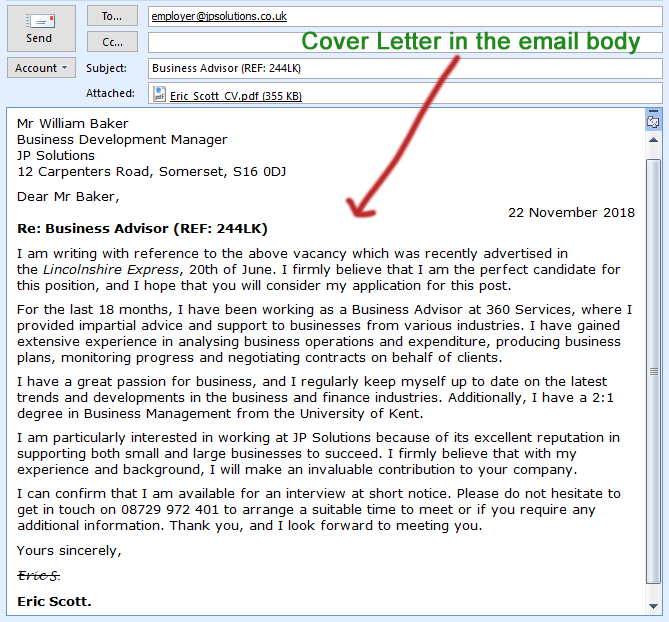
I can already hear you ask “which one is better?” glad you asked.
Our recommendation is to write the cover letter in the body of the email. It gives the opportunity to make a strong and memorable first impression, allowing you to grab the prospective employer’s attention within seconds.
If you send it as an attachment, on the other hand, the employer has to take the additional step of finding and opening your letter in order to read it. Some recruiters will not open attachments out of fear of infecting their computers by viruses.
Warning: Don’t include the same cover letter in the body of the email and as a file attachment. That is just a weird thing to do and makes you look very indecisive.
The remainder of the guide will show you step-by-step how to write your email covering letter in the body of the email:
How to start an email
2. employer’s personal details.
The first few lines of your letter should be the personal details of the recruiter:
- Recruiter’s full name
- Recruiter’s job title
- Company name
- Company address
Good example:

3. Opening salutation/greeting
The next line of your covering letter is the opening salutation, which should be written in the following format:
“Dear” followed by their honorific title (Mr, Mrs, etc.) and surname.
- Always use formal greeting (e.g. ‘ Dear Sir/Madam ‘, ‘ Dear [Surname] ‘ or ‘ To whom it may concern ‘ rather than ‘ Hey ‘, ‘ Hi ‘, or ‘ What’s up? ‘)
- It’s always best to find out the name of the employer to whom you are written the letter. This makes the letter more personal and convincing.
- If you’re addressing the employer by name, only include their surname (Dear Mr Kent) and not their full name (Dear Mr Simon Kent).

The next line should include today’s date in full ( 10 November, 2018 instead of 10/11/18 ), aligned to the right.
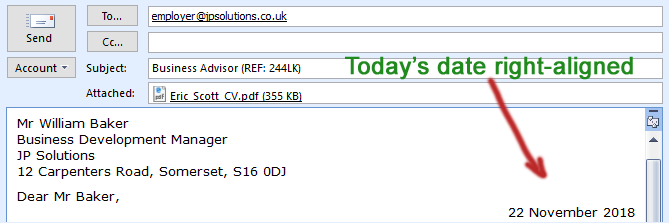
5. Introductory paragraph
State the reason why you are writing this covering letter.
For example:
I am writing to express my interest in the Electrical Engineer role listed in The Worcester News, 19th of March 2017. After carefully reviewing the job requirements, I feel I have all the necessary experience and technical skills to excel in this position, and I would wholly appreciate your consideration.
- These are the first few sentences that the prospective employer will be reading about you; make sure the introductory paragraph is short , to the point and is written for high impact .
6. Paragraph 2
In this paragraph, clearly outline the reasons why you would be a suitable candidate for this position. Make mention of your relevant education, qualifications, work experience, strengths, skills and abilities.
I graduated in 2014 with a first-class degree in Librarianship from the University of Essex, and I worked for a year as a Junior Librarian at Summerfield College. Both my education and work experience have given me a great insight into the purpose, function and processes of libraries. I am trained in all the standard library information and data management systems.
- Try to back up your statements with real-world examples. For instance, if you wrote that you have an “ excellent track record in sales “; back it up by tangible and verifiable performance information, e.g. by stating that you “ increased the company’s sales by 23% in six months. “
7. Paragraph 3
Following on from paragraph 2, expand on more reasons why you would be the ideal candidate for this job position.
I graduated in 2015 with a 2:1 degree in Business Management from the Queen’s University Belfast, something which kindled my passion for business and the economy. I studied a broad variety of topics ranging from Marketing Principles and Corporate Responsibilities to Leading Change and Strategic Management. I am a driven, ambitious and analytical individual with the excellent ability to analyse current business operations and offer meaningful solutions based on the findings.
8. Paragraph 4
This is going to be the final information-packed paragraph of your cover letter. Mention any other selling points that you have and state the reason why you are interested in working for this particular company.
I am especially attracted to joining your organisation because of the emphasis it puts on long-term growth and training within the company. Challenges motivate me, and I believe that I would be able to bring together my prior knowledge and skills as a competent Recruitment Officer. I am confident that my records of impressive accomplishments over the past few years prove that I will become a valuable asset to Lancefield Recruitment.
- Do research about the company you are applying for and use your findings to draft this paragraph. This will make you look interested, intelligent and resourceful in the eyes of the prospective employer.
How to end the email
9. closing statement.
The final paragraph is usually a polite call for action in which you state that you are looking forward to meeting the prospective employer. It must also contain a reference to your CV that you have attached with the application.
Useful phrases you can use:
- Please find attached my CV for your consideration.
- I have attached my CV with this email.
- For your consideration, my CV is attached with this email.

10. Closing salutation
The closing greeting should be “Yours sincerely” only if you addressed the employer by name (e.g. Dear Mrs Sanders) at the beginning of the letter.
If you used “Dear Sir/Madam” or “To whom it may concern” as the opening greeting of your letter, it should end with “Yours faithfully.”
Other alternatives that you may use instead of “Yours faithfully”:
- Best regards
- Kind regards
- Best Wishes
11. Signature & Sender’s name
Sign off the letter with a signature followed by your name.
If you do not have a scanned or electronic signature, you can write the signature in the following format:
- Email address
- Telephone number
- LinkedIn profile – optional

That is it – you should now have a perfectly written email cover letter!
- Don’t rush by writing and sending your email in one go – you will most likely forget to include important things or make many factual, grammatical or spelling mistakes. Write a draft version first, take a break, and then come back again in a few hours time to review it.
- Don’t forget to attach your files ! You only have one chance to make a good impression, make sure you don’t mess it up with clumsy mistakes.
- Send a test email to yourself first to double-check the email’s format and whether attachments can be opened.
- Give the attachments identifiable file names, for example, “ Julia_McCaree_CV.pdf ” is better than “ newhkh34.pdf “
Shall I send my documents in Word (.doc or .docx) or PDF format? Both methods are acceptable. However, we recommend you send it as a PDF file because that will preserve the format and presentation of your documents; including margins, padding, spacing and indentation.
How do I find out if my job application email has been received? Unfortunately, you can’t be sure whether the employer has opened or read your email unless they tell you so. Some email clients allow you to ask for a “Read” receipt after the sender has opened your email. However, you will only receive a “Read” receipt if the recipient decides to send you one.
After how many days shall I follow-up my application? Most job vacancies will state the timeframe in which you should hear back from them if you have been shortlisted for an interview. Many job vacancies will state: “If you do not hear back from us within 2 weeks time, please assume that your application has been unsuccessful this time.” If, however, this is not specified you should get in touch with them after a week to follow-up on your initial application.
Should I use the “ high importance ” flag when sending my application? No, not really. The high importance flag has lost its value years ago. Besides, there is a chance that you will come across as rude as why should your job application email be more important or urgent than those of other senders? More than 90% of emails are sent without one.
Working on your CV? Awesome!
- Made simple: CV Employment History
- What personal details to put on a CV (2024 Guide + Examples)
- Best CV Personal Profile Examples
- The Best Cleaner CV Example [2024 Guide + Tips]
Over 15,000 amazing people have connected with us - and you're amazing too!
Copyright © 2024 CV Plaza All Rights Reserved
Privacy Overview
Resume Templates
Resume samples

Create and edit your resume online
Generate compelling resumes with our AI resume builder and secure employment quickly.
Write a cover letter

Cover Letter Examples
Cover Letter Samples

Create and edit your cover letter
Use our user-friendly tool to create the perfect cover letter.
Featured articles
- How to Write a Motivation Letter With Examples
- How to Write a Resume in 2024 That Gets Results
- Teamwork Skills on Your Resume: List and Examples
- What Are the Best Colors for Your Resume?
Latests articles
- Top 5 Tricks to Transform Your LinkedIn Profile With ChatGPT
- Using ChatGPT to Prepare for Interviews: Top Tips and Steps
- How to Create an Effective Cover Letter with ChatGPT
- 10 Jobs in High Demand in 2024: Salaries and Expected Growth

Dive Into Expert Guides to Enhance your Resume
How to Email a Resume and Cover Letter to an Employer

When you are job hunting, emailing your resume and cover letter is a standard part of the process. But what is the best way to email a resume ?
Potential employers are very quick to judge so it is essential to make a positive first impression . The email you send is the first thing they see so it is important to get it right.
If you have spent time writing an attractive professional resume it would be tragic to fall at the first hurdle by making a mistake when you email a resume and cover letter .
Thankfully, it is not rocket science. Using this step-by-step on how to email a resume to a potential employer will help to get your resume noticed.
Follow the employers’ instructions
When you are sending your resume by email it is important to follow the employer’s instructions to the letter. Failure to do so will show that you either have not read the job posting properly, or you have poor attention to detail.
The job advert normally gives detailed instructions on how to send your resume in an email . The details often state the resume format you should use, what you should include in the subject line of the email, what attachments you should send, and when the deadline is, among other information.
How to choose the correct resume file format
Employers normally ask for resumes to be sent either as a PDF document or as a Word document (.doc). If the required resume format is not stated in the job posting you can send your email resume as a .pdf or .doc.
There are various mistakes that candidates make on their resumes, so before you save it, make sure you have avoided the most common mistakes when writing a resume .
To save your resume as a Word document click ‘File’, ‘Save as’, then there should be an option to save it as a Word (.doc or .docx) file.
How to save your resume as a PDF depends on what word processing software you use. Normally, you can click ‘File’, ‘Print to PDF’/’Export as PDF’, and then save the file. Read some tips on choosing a good resume file name to make sure that it is named appropriately.
Writing a cover letter
Depending on the position, you might need to write a cover letter to provide additional information on your experience , expertise, why you are applying for the job , and why you are a good fit for the position.
Sometimes employers give specific instructions on what you should write about in your cover letter, make sure you follow these. The resume cover letter should demonstrate why you are a strong candidate for a position.
The cover letter should be as well written as your resume and any other documentation you send an employer. Use formal English .
There are two email formats which you can use to include your cover letter . You can either copy and paste it into the main body of the email, or include it as a PDF or Word document .
If you send the resume cover email as an attachment, you still need to write an email for attaching the resume. Write a formal email stating why you are applying for the position and that your resume and cover letter are attached.
How to email a resume to a company: final checklist
Once you have written your resume email and cover letter , there are some crucial things you should check before you send the email. There are some typical rookie mistakes to avoid, using a resume builder will help you to achieve this. Here are some final tips on how to email a resume to a company.
Keep it simple
Do not use a fun, crazy, or alternative font, use a simple one such as Arial, Calibri or Verdana. Also, avoid using HTML as you do not know if the employer will be able to see it.
Send attachments correctly
It is incredible how many people forget to attach their resume to their email. This looks forgetful and amateurish. Double check you have included all the correct attachments before you send the email.
Don’t Forget the Details
The email with your resume should include a subject line and a signature with your contact details. The subject line should include the position which you are applying for, if you do not include this your email may never be opened.
Proofread everything many times
Typos and small mistakes look unprofessional. Before you email a resume, proofread all of the documentation. Check it for clarity, spelling, and grammar. Also, pay special attention to names.

Struggling with Resume Writing?
Ease the process with our templates
Related Posts
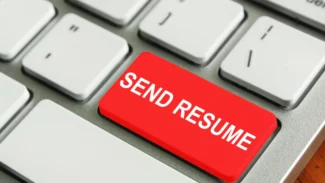
How to Write a Cover Letter [Full Guide & Examples for 2024]

After weeks of heavy job searching, you’re almost there!
You’ve perfected your resume.
You’ve short-listed the coolest jobs you want to apply for.
You’ve even had a friend train you for every single interview question out there.
But then, before you can send in your application and call it a day, you remember that you need to write a cover letter too.
So now, you’re stuck staring at a blank page, wondering where to start...
Don’t panic! We’ve got you covered. Writing a cover letter is a lot simpler than you might think.
In this guide, we’re going to teach you how to write a cover letter that gets you the job you deserve.
We're going to cover:
What Is a Cover Letter?
- How to Write the Perfect Cover Letter, Step by Step
- 15+ Job-Winning Cover Letter Examples
Let’s get started.
A cover letter is a document that you submit as part of your job application, alongside your resume or CV.
The purpose of a cover letter is to introduce you and briefly summarize your professional background. On average, it should be around 250 to 400 words long .
A good cover letter is supposed to impress the hiring manager and convince them you’re worth interviewing as a candidate.
So, how can your cover letter achieve this?
First of all, it should complement your resume, not copy it. Your cover letter is your chance to elaborate on important achievements, skills, or anything else that your resume doesn’t give you the space to cover.
For example, if you have an employment gap on your resume, the cover letter is a great place to explain why it happened and how it helped you grow as a person.
If this is your first time writing a cover letter, writing about yourself might seem complicated. But don’t worry—you don’t need to be super creative or even a good writer .
All you have to do is follow this tried and tested cover letter structure:

- Header. Add all the necessary contact information at the top of your cover letter.
- Formal greeting. Choose an appropriate way to greet your target audience.
- Introduction. Introduce yourself in the opening paragraph and explain your interest in the role.
- Body. Elaborate on why you’re the best candidate for the job and a good match for the company. Focus on “selling” your skills, achievements, and relevant professional experiences.
- Conclusion. Summarize your key points and wrap it up professionally.
Now, let’s take a look at an example of a cover letter that follows our structure perfectly:

New to cover letter writing? Give our cover letter video a watch before diving into the article!
When Should You Write a Cover Letter?
You should always include a cover letter in your job application, even if the hiring manager never reads it. Submitting a cover letter is as important as submitting a resume if you want to look like a serious candidate.
If the employer requests a cover letter as part of the screening process, not sending one is a huge red flag and will probably get your application tossed into the “no” pile immediately.
On the other hand, if the job advertisement doesn’t require a cover letter from the candidates, adding one shows you went the extra mile.
Putting in the effort to write a cover letter can set you apart from other candidates with similar professional experience and skills, and it could even sway the hiring manager to call you for an interview if you do it right.
Need to write a letter to help get you into a good school or volunteer program? Check out our guide to learn how to write a motivation letter !
How to Write the Perfect Cover Letter
Now that you know what a cover letter is, it’s time to learn how to write one!
We’ll go through the process in detail, step by step.
#1. Choose the Right Cover Letter Template
A good cover letter is all about leaving the right first impression.
So, what’s a better way to leave a good impression than a well-formatted, stylish template?

Just choose one of our hand-picked cover letter templates , and you’ll be all set in no time!
As a bonus, our intuitive AI will even give you suggestions on how to improve your cover letter as you write it. You’ll have the perfect cover letter done in minutes!

#2. Put Contact Information in the Header
As with a resume, it’s important to
start your cover letter
with your contact details at the top. These should be in your cover letter’s header, separated neatly from the bulk of your text.

Here, you want to include all the essential contact information , including:
- Full Name. Your first and last name should stand out at the top.
- Job Title. Match the professional title underneath your name to the exact job title of the position you’re applying for. Hiring managers often hire for several roles at once, so giving them this cue about what role you’re after helps things go smoother.
- Email Address. Always use a professional and easy-to-spell email address. Ideally, it should combine your first and last names.
- Phone Number. Add a number where the hiring manager can easily reach you.
- Location. Add your city and state/country, no need for more details.
- Relevant Links (optional). You can add links to websites or social media profiles that are relevant to your field. Examples include a LinkedIn profile , Github, or an online portfolio.
Then it’s time to add the recipient’s contact details, such as:
- Hiring Manager's Name. If you can find the name of the hiring manager, add it.
- Hiring Manager's Title. While there’s no harm in writing “hiring manager,” if they’re the head of the department, we recommend you use that title accordingly.
- Company Name. Make sure to write the name of the company you're applying to.
- Location. The city and state/country are usually enough information here, too.
- Date of Writing (Optional). You can include the date you wrote your cover letter for an extra professional touch.

#3. Address the Hiring Manager
Once you’ve properly listed all the contact information, it’s time to start writing the content of the cover letter.
The first thing you need to do here is to address your cover letter directly to the hiring manager.
In fact, you want to address the hiring manager personally .
Forget the old “Dear Sir or Madam” or the impersonal “To Whom It May Concern.” You want to give your future boss a good impression and show them that you did your research before sending in your application.
No one wants to hire a job seeker who just spams 20+ companies and hopes something sticks with their generic approach
So, how do you find out who’s the hiring manager?
First, check the job ad. The hiring manager’s name might be listed somewhere in it.
If that doesn’t work, check the company’s LinkedIn page. You just need to look up the head of the relevant department you’re applying to, and you’re all set.
For example, if you’re applying for the position of Communication Specialist at Novorésumé. The hiring manager is probably the Head of Communications or the Chief Communications Officer.
Here’s what you should look for on LinkedIn:

And there you go! You have your hiring manager.
But let’s say you’re applying for a position as a server . In that case, you’d be looking for the “restaurant manager” or “food and beverage manager.”
If the results don’t come up with anything, try checking out the “Team” page on the company website; there’s a good chance you’ll at least find the right person there.
Make sure to address them as Mr. or Ms., followed by their last name. If you’re not sure about their gender or marital status, you can just stick to their full name, like so:
- Dear Mr. Kurtuy,
- Dear Andrei Kurtuy,
But what if you still can’t find the hiring manager’s name, no matter where you look?
No worries. You can direct your cover letter to the company, department, or team as a whole, or just skip the hiring manager’s name.
- Dear [Department] Hiring Manager
- Dear Hiring Manager
- Dear [Department] Team
- Dear [Company Name]
Are you applying for a research position? Learn how to write an academic personal statement .
#4. Write an Eye-Catching Introduction
First impressions matter, especially when it comes to your job search.
Hiring managers get hundreds, sometimes even thousands, of applications. Chances are, they’re not going to be reading every single cover letter end-to-end.
So, it’s essential to catch their attention from the very first paragraph.
The biggest problem with most opening paragraphs is that they’re usually extremely generic. Here’s an example:
- My name is Jonathan, and I’d like to work as a Sales Manager at XYZ Inc. I’ve worked as a Sales Manager at MadeUpCompany Inc. for 5+ years, so I believe that I’d be a good fit for the position.
See the issue here? This opening paragraph doesn’t say anything except the fact that you’ve worked the job before.
And do you know who else has similar work experience? All the other applicants you’re competing with.
Instead, you want to start with some of your top achievements to grab the reader’s attention. And to get the point across, the achievements should be as relevant as possible to the position.
Your opening paragraph should also show the hiring manager a bit about why you want this specific job. For example, mention how the job relates to your plans for the future or how it can help you grow professionally. This will show the hiring manager that you’re not just applying left and right—you’re actually enthusiastic about getting this particular role.
Now, let’s make our previous example shine:
Dear Mr. Smith,
My name’s Michael, and I’d like to help XYZ Inc. hit and exceed its sales goals as a Sales Manager. I’ve worked as a Sales Representative with Company X, another fin-tech company , for 3+ years, where I generated an average of $30,000+ in sales per month and beat the KPIs by around 40%. I believe that my previous industry experience, passion for finance , and excellence in sales make me the right candidate for the job.
The second candidate starts with what they can do for the company in the future and immediately lists an impressive and relevant achievement. Since they’re experienced in the same industry and interested in finance, the hiring manager can see they’re not just a random applicant.
From this introduction, it’s safe to say that the hiring manager would read the rest of this candidate’s cover letter.
#5. Use the Cover Letter Body for Details
The next part of your cover letter is where you can go into detail about what sets you apart as a qualified candidate for the job.
The main thing you need to remember here is that you shouldn’t make it all about yourself . Your cover letter is supposed to show the hiring manager how you relate to the job and the company you’re applying to.
No matter how cool you make yourself sound in your cover letter, if you don’t tailor it to match what the hiring manager is looking for, you’re not getting an interview.
To get this right, use the job ad as a reference when writing your cover letter. Make sure to highlight skills and achievements that match the job requirements, and you’re good to go.
Since this part of your cover letter is by far the longest, you should split it into at least two paragraphs.
Here’s what each paragraph should cover:
Explain Why You’re the Perfect Candidate for the Role
Before you can show the hiring manager that you’re exactly what they’ve been looking for, you need to know what it is they’re looking for.
Start by doing a bit of research. Learn what the most important skills and responsibilities of the role are according to the job ad, and focus on any relevant experience you have that matches them.
For example, if you’re applying for the position of a Facebook Advertiser. The top requirements on the job ad are:
- Experience managing a Facebook ad budget of $10,000+ / month
- Some skills in advertising on other platforms (Google Search + Twitter)
- Excellent copywriting skills
So, in the body of your cover letter, you need to show how you meet these requirements. Here’s an example of what that can look like:
In my previous role as a Facebook Marketing Expert at XYZ Inc. I handled customer acquisition through ads, managing a monthly Facebook ad budget of $40,000+ . As the sole digital marketer at the company, I managed the ad creation and management process end-to-end. I created the ad copy and images, picked the targeting, ran optimization trials, and so on.
Other than Facebook advertising, I’ve also delved into other online PPC channels, including:
- Google Search
Our example addresses all the necessary requirements and shows off the candidate’s relevant skills.
Are you a student applying for your first internship? Learn how to write an internship cover letter with our dedicated guide.
Explain Why You’re a Good Fit for the Company
As skilled and experienced as you may be, that’s not all the hiring manager is looking for.
They also want someone who’s a good fit for their company and who actually wants to work there.
Employees who don’t fit in with the company culture are likely to quit sooner or later. This ends up costing the company a ton of money, up to 50% of the employee’s annual salary , so hiring managers vet candidates very carefully to avoid this scenario.
So, you have to convince the hiring manager that you’re passionate about working with them.
Start by doing some research about the company. You want to know things like:
- What’s the company’s business model?
- What’s the company’s product or service? Have you used it?
- What’s the company’s culture like?
Chances are, you’ll find all the information you need either on the company website or on job-search websites like Jobscan or Glassdoor.
Then, pick your favorite thing about the company and talk about it in your cover letter.
But don’t just describe the company in its own words just to flatter them. Be super specific—the hiring manager can see through any fluff.
For example, if you’re passionate about their product and you like the company’s culture of innovation and independent work model, you can write something like:
I’ve personally used the XYZ Smartphone, and I believe that it’s the most innovative tech I’ve used in years. The features, such as Made-Up-Feature #1 and Made-Up-Feature #2, were real game changers for the device.
I really admire how Company XYZ strives for excellence in all its product lines, creating market-leading tech. As someone who thrives in a self-driven environment, I truly believe that I’ll be a great match for your Product Design team.
So, make sure to do your fair share of research and come up with good reasons why you're applying to that specific company.
Is the company you want to work for not hiring at the moment? Check out our guide to writing a letter of interest .
#6. Wrap It Up and Sign It
Finally, it’s time to conclude your cover letter.
In the final paragraph, you want to:
- Wrap up any points you couldn't make in the previous paragraphs. Do you have anything left to say? If there’s any other information that could help the hiring manager make their decision, mention it here. If not, just recap your key selling points so far, such as key skills and expertise.
- Express gratitude. Politely thanking the hiring manager for their time is always a good idea.
- Finish the cover letter with a call to action. The very last sentence in your cover letter should be a call to action. This means you should ask the hiring manager to do something, like call you and discuss your application or arrange an interview.
- Remember to sign your cover letter. Just add a formal closing line and sign your name at the bottom.
Here’s an example of how to end your cover letter :
I hope to help Company X make the most of their Facebook marketing initiatives. I'd love to further discuss how my previous success at XYZ Inc. can help you achieve your Facebook marketing goals. Please don’t hesitate to reach out to me at the provided email address or phone number so that we may arrange an interview.
Thank you for your consideration,
Alice Richards
Feel free to use one of these other popular closing lines for your cover letter:
- Best Regards,
- Kind Regards,
Cover Letter Writing Checklist
Once you’re done with your cover letter, it’s time to check if it meets all industry requirements.
Give our handy cover letter writing checklist a look to make sure:
Does your cover letter heading include all essential information?
- Professional Email
- Phone Number
- Relevant Links
Do you address the right person?
- The hiring manager in the company
- Your future direct supervisor
- The company/department in general
Does your introductory paragraph grab the reader's attention?
- Did you mention some of your top achievements?
- Did you use numbers and facts to back up your experience?
- Did you convey enthusiasm for the specific role?
Do you show that you’re the right candidate for the job?
- Did you identify the core requirements for the role?
- Did you show how your experiences helped you fit the requirements perfectly?
Do you convince the hiring manager that you’re passionate about the company you’re applying to?
- Did you identify the top 3 things that you like about the company?
- Did you avoid generic reasons for explaining your interest in the company?
Did you conclude your cover letter properly?
- Did you recap your key selling points in the conclusion?
- Did you end your cover letter with a call to action?
- Did you use the right formal closing line and sign your name?
15 Cover Letter Tips
Now you’re all set to write your cover letter!
Before you start typing, here are some cover letter tips to help take your cover letter to the next level:
- Customize Your Cover Letter for Each Job. Make sure your cover letter is tailored to the job you're applying for. This shows you're not just sending generic applications left and right, and it tells the hiring manager you’re the right person for the job.
- Showcase Your Skills. Talk about how your skills meet the company’s needs. And while your hard skills should be front and center, you shouldn’t underestimate your soft skills in your cover letter either.
- Avoid Fluff. Don’t make any generic statements you can’t back up. The hiring manager can tell when you’re just throwing words around, and it doesn’t make your cover letter look good.
- Use Specific Examples. Instead of saying you're great at something, give an actual example to back up your claim. Any data you can provide makes you sound more credible, so quantify your achievements. For example, give numbers such as percentages related to your performance and the timeframe it took to accomplish certain achievements.
- Research the Company. Always take time to learn about the company you're applying to. Make sure to mention something about them in your cover letter to show the hiring manager that you're interested.
- Follow the Application Instructions. If the job posting asks for something specific in your cover letter or requires a certain format, make sure you include it. Not following instructions can come off as unattentive or signal to the hiring manager that you’re not taking the job seriously.
- Use the Right Template and Format. Choose the right cover letter format and adapt your cover letter’s look to the industry you’re applying for. For example, if you’re aiming for a job in Law or Finance, you should go for a cleaner, more professional look. But if you’re applying for a field that values innovation, like IT or Design, you have more room for creativity.
- Express Your Enthusiasm. Let the hiring manager know why you're excited about the job. Your passion for the specific role or the field in general can be a big selling point, and show them that you’re genuinely interested, not just applying left and right.
- Address Any Gaps. If there are any employment gaps in your resume , your cover letter is a great place to mention why. Your resume doesn’t give you enough space to elaborate on an employment gap, so addressing it here can set hiring managers at ease—life happens, and employers understand.
- Avoid Quirky Emails. Your email address should be presentable. It’s hard for a hiring manager to take you seriously if your email address is “[email protected].” Just use a [email protected] format.
- Check Your Contact Information. Typos in your email address or phone number can mean a missed opportunity. Double-check these before sending your application.
- Mention if You Want to Relocate. If you’re looking for a job that lets you move somewhere else, specify this in your cover letter.
- Keep It Brief. You want to keep your cover letter short and sweet. Hiring managers don’t have time to read a novel, so if you go over one page, they simply won’t read it at all.
- Use a Professional Tone. Even though a conversational tone isn’t a bad thing, remember that it's still a formal document. Show professionalism in your cover letter by keeping slang, jargon, and emojis out of it.
- Proofread Carefully. Typos and grammar mistakes are a huge deal-breaker. Use a tool like Grammarly or QuillBot to double-check your spelling and grammar, or even get a friend to check it for you.
15+ Cover Letter Examples
Need some inspiration? Check out some perfect cover letter examples for different experience levels and various professions.
5+ Cover Letter Examples by Experience
#1. college student cover letter example.

Check out our full guide to writing a college student cover letter here.
#2. Middle Management Cover Letter Example

Check out our full guide to writing a project manager cover letter here.
#3. Team Leader Cover Letter Example

Check out our full guide to writing a team leader cover letter here.
#4. Career Change Cover Letter Example

Check out our full guide to a career change resume and cover letter here.
#5. Management Cover Letter Example

Check out our full guide to writing a management cover letter here.
#6. Senior Executive Cover Letter Example

Check out our full guide to writing an executive resume here.
9+ Cover Letter Examples by Profession
#1. it cover letter example.

Check out our full guide to writing an IT cover letter here.
#2. Consultant Cover Letter Example

Check out our full guide to writing a consultant cover letter here.
#3. Human Resources Cover Letter

Check out our full guide to writing a human resources cover letter here.
#4. Business Cover Letter Example

Check out our full guide to writing a business cover letter here.
#5. Sales Cover Letter Example

Check out our full guide to writing a sales cover letter here.
#6. Social Worker Cover Letter

Check out our full guide to writing a social worker cover letter here.
#7. Lawyer Cover Letter

Check out our full guide to writing a lawyer cover letter here.
#8. Administrative Assistant Cover Letter

Check out our full guide to writing an administrative assistant cover letter here.
#9. Engineering Cover Letter Example

Check out our full guide to writing an engineer cover letter here.
#10. Receptionist Cover Letter Example

Check out our full guide to writing a receptionist cover letter here.
Need more inspiration? Check out these cover letter examples to learn what makes them stand out.
Plug & Play Cover Letter Template
Not sure how to start your cover letter? Don’t worry!
Just copy and paste our free cover letter template into the cover letter builder, and swap out the blanks for your details.
[Your Full Name]
[Your Profession]
[Your Phone Number]
[Your Email Address]
[Your Location]
[Your LinkedIn Profile URL (optional)]
[Your Personal Website URL (optional)]
[Recipient's Name, e.g., Jane Doe],
[Recipient's Position, e.g., Hiring Manager]
[Company Name, e.g., ABC Corporation]
[Company Address]
[City, State/Country]
Dear [Recipient's Name],
As a seasoned [Your Profession] with [Number of Years of Experience] years of industry experience, I am eager to express my interest in the [Job Title] position at [Company Name]. With my experience in [Your Industry/Sector] and the successes I've achieved throughout my education and career, I believe I can bring unique value and creativity to your team.
In my current role as [Your Current Job Title], I've taken the lead on more than [Number of Projects/Assignments] projects, some valued up to $[Highest Project Value]. I pride myself on consistently exceeding client expectations and have successfully [Mention a Key Achievement] in just a [Amount of Time] through [Skill] and [Skill].
I've collaborated with various professionals, such as [List Roles], ensuring that all [projects/tasks] meet [relevant standards or objectives]. This hands-on experience, coupled with my dedication to understanding each [client's/customer's] vision, has equipped me to navigate and deliver on complex projects.
My key strengths include:
- Improving [Achievement] by [%] over [Amount of Time] which resulted in [Quantified Result].
- Optimizing [Work Process/Responsibility] which saved [Previous Employer] [Amount of Time/Budget/Other Metric] over [Weeks/Months/Years]
- Spearheading team of [Number of People] to [Task] and achieving [Quantified Result].
Alongside this letter, I've attached my resume. My educational background, a [Your Degree] with a concentration in [Your Specialization], complements the practical skills that I'm particularly eager to share with [Company Name].
I'm excited about the possibility of contributing to [Something Notable About the Company or Its Mission]. I'd be grateful for the chance to delve deeper into how my expertise aligns with your needs.
Thank you for considering my application, and I look forward to hearing from you soon.
The Heart of Your Job Search - Creating a Killer Resume
Your cover letter is only as good as your resume. If either one is weak, your entire application falls through.
After all, your cover letter is meant to complement your resume. Imagine going through all this effort to leave an amazing first impression in your cover letter, only for the hiring manager to never read it because your resume was mediocre.
But don’t worry; we’ve got you covered here, too.
Check out our dedicated guide on how to make a resume and learn everything you need to know to land your dream job!
Just pick one of our resume templates and start writing your own job-winning resume.

Key Takeaways
Now that we’ve walked you through all the steps of writing a cover letter, let’s summarize everything we’ve learned:
- A cover letter is a 250 - 400 word document that’s meant to convince the hiring manager that you’re the best candidate for the job.
- Your job application should always include a cover letter alongside your resume.
- To grab the hiring manager’s attention, write a strong opening paragraph. Mention who you are, why you’re applying, and a standout achievement to pique their interest.
- Your cover letter should focus on why you’re the perfect candidate for the job and why you’re passionate about working in this specific company.
- Use the body of your cover letter to provide details on your skills, achievements, and qualifications, as well as make sure to convey your enthusiasm throughout your whole cover letter.
- Recap your key selling points towards the end of your cover letter, and end it with a formal closing line and your full name signed underneath.
At Novorésumé, we’re committed to helping you get the job you deserve every step of the way!
Follow our career blog for more valuable advice, or check out some of our top guides, such as:
- How to Make a Resume in 2024 | Beginner's Guide
- How to Write a CV (Curriculum Vitae) in 2024 [31+ Examples]
- 35+ Job Interview Questions and Answers [Full List]

To provide a safer experience, the best content and great communication, we use cookies. Learn how we use them for non-authenticated users.
How to Attach a Cover Letter
- Cover Letters
- ')" data-event="social share" data-info="Pinterest" aria-label="Share on Pinterest">
- ')" data-event="social share" data-info="Reddit" aria-label="Share on Reddit">
- ')" data-event="social share" data-info="Flipboard" aria-label="Share on Flipboard">
How to Mail a Cover Letter & Resume for Jobs
How to address someone when seeking employment in a letter, how to attach a cover letter to a resume when you have to use an employer website.
- Guidelines for Writing a Letter Requesting a Job Interview
- Can You Be an Advanced Practice Nurse Without a Master's Degree?
While creating a resume that displays your skills, experience and suitability for a position is vital to landing an interview, most employers will not even glance at a resume that does not have a cover letter attached. The manner in which you enclose a cover letter depends on whether you are mailing a hard copy resume or sending an electronic version via email. Following the employer's specific guidelines is key, as well.
Sending a Physical Cover Letter
Print your resume on the same type of paper, which should be cream or light gray paper.
Stack your cover letter neatly on top of your resume. Avoid stapling or clipping the letter to the resume pages.
Place the cover letter and resume into a large envelope without folding the pages. Address and mail the envelope.
Emailing a Cover Letter
Check the job posting for any requirements on how to send the cover letter. Some employers ask that you attach the letter as a Word or text document.
Save the letter in the specified format, and attach it to your email. Type a brief yet professional message stating your interest into the body of the email message. Inform the recipient that your cover letter and resume are attached as requested.
Type the letter into the body of the email message if the employer does not ask you to attach it as a document. Write a brief yet professional one- to two-paragraph letter indicating your interest. Highlight one or two skills that make you ideal for the position.
Attach the resume to the email message, address it to the proper recipient and send the email.
- Castleton Career Services: Job Search Kit
- Hampshire College: Emailing Your Cover Letter and Resume
- Calvin College Career Development: Applying for Jobs Using E-mail
Tricia Goss' credits include Fitness Plus, Good News Tucson and Layover Magazine. She is certified in Microsoft application and served as the newsletter editor for OfficeUsers.org. She has also contributed to The Dollar Stretcher, Life Tips and Childcare Magazine.
Related Articles
What are the duties of a call center human resources manager, the negative effects of quitting a job, how to make a free printable resume with a form, how much do medical malpractice lawyers make, how to upload a resume on linkedin, how to format a header for a two page resume, email format for a follow-up resume, how to head a friendly letter, how to format business references, most popular.
- 1 What Are the Duties of a Call Center Human Resources Manager?
- 2 The Negative Effects of Quitting a Job
- 3 How to Make a Free Printable Resume With a Form
- 4 How Much Do Medical Malpractice Lawyers Make?

How to write a cover letter for your CV
If you want to land the best jobs, you need to accompany your CV with a strong cover letter.
In this guide, I will show you how to write a cover letter that will get you noticed by employers and ensure you land plenty of interviews.
Starting with a basic overview…
To write an effective cover letter you must:
- Apply a professional format and layout
- Address the recipient by name
- Explain why you are suitable for the job you are applying for
- Explain why you are applying for the job
- Encourage the recruiter to open your CV
What is a cover letter?
Before you delve into this guide, it’s important to understand what a cover letter is, and what it’s purpose is.
Having a good understanding of these 2 factors will help you to create a really effective cover letter.
A cover letter is simply an introductory note which you send to recruiters and employers, when sending your CV
Here’s an example of a typical cover letter
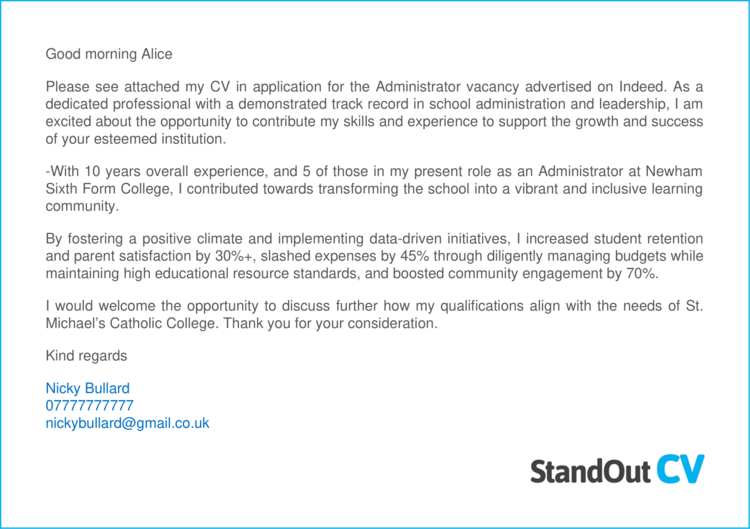
What’s the purpose of a cover letter?
The purpose of your cover letter is to do the following 3 things;
- Introduce yourself
- Build rapport with the recruiter or employer
- Encourage them to open your CV
Cover letter format
Before you start to write your cover letter, you need to understand the basics of formatting one, and the structure to follow.
Using the correct format will ensure that your cover letter is easy for busy recruiters to read, and that you can highlight the important information that they want to see.
Use the following tips to format and layout your CV for best results.
Write your cover letter in the body of your message or email
The number one cover letter formatting rule to remember is, write your cover letter in the body of your email (or messaging box if you are sending via a job website ).

Never attach your cover letter as a separate document.
You want your cover letter to be instantly visible to recruiters and employers, form the moment they open your application.
If you attach it separately, you simply slowing down the process, and run the risk of having your application ignored (especially if it takes a long time for the document to open).
So, always write your cover letter in the body of your application message if you want to make an instant connection with the recipient.
Quick tip: If you are writing your cover letter in an email, use an eye-catching subject line that tailors your skills to the jobs. E.g. Developer with 5 years web app experience

Cover letter layout
Every cover letter will be different of course, but try to stick to this basic layout as much as possible, in order to provide the right information, in a logical order.
This will help you to build rapport with readers, and sell yourself to them in the short window of their attention you have.
Start by addressing the recipient
The first thing you need to do in your cover letter, is address the person you are approaching.

Follow with a friendly greeting
You want to appear professional when applying for jobs, but you also need to be friendly and personable.
So, follow with a friendly greeting such as;
- Hope you’re well
- I hope this email finds you well
Always remember that your message will be read by a real person, and they will appreciate being treated well.
Explain which job you are applying for
Once you’ve greeted and warmed up the recruiter with a friendly opening, it’s time to get to the point.
Let the recruiter know exactly which job you are applying for.

Remember that some recruiters will be working scores of vacancies, so be as specific as you can.
Explain why you are suitable for the job
In the body of your cover letter, you should provide a brief explanation of what makes you suitable for the job you are applying for.
This is ultimately what will encourage a recruiter or hiring manager to open your CV .

I will cover how to do this in more detail in the “W hat to include in a cover letter ” section of the guide.
Sign off in a friendly and professional manner
Remembering that your cover letter is a means of communication with the person receiving it – sign off in a friendly yet professional way.
Use a term like;
- Kind regards
- Look forward to hearing from you
Finish with a professional signature
Finally, at the very bottom of your cover letter, add a professional signature .
This will ensure it looks professional, and provide the reader with instant access to your contact details.

Quick tip: If you are writing a cover letter in email, format your signature to make it look extra-professional, and save it as your default signature for all of your outgoing mails.
How to start a cover letter
To start a cover letter, you should always aim to address the recipient by name – this is the best way to start building rapport.

But you are probably thinking, “How do I find their name??”
There are a few ways you can find the name of the person handling the vacancy
- On the job advert – sometimes the name and email address will be on the job advert itself
- Company website – If you’re applying directly to a company, you can often find the recruitment team or head of department on the company About us section
- LinkedIn – If you can determine the company and team for the vacancy, a search on LinkedIn can often uncover the most likely person to be handling the applications.
“What if I can’t find a name?”
If you can’t find a name, don’t panic – you won’t always be able to.
Simply address the recruiter with the word “Hi” – that’s all you can do in that instance.
Don’t use the phrase “ Dear sir or madam” – It’s very old-fashioned and impersonal.
How long should a cover letter be?
A cover letter should be short and sweet.
The purpose of a cover letter, is simply to persuade recruiters to open your CV, so it doesn’t need to be long .
You only need 3 – 6 sentences to write a good cover letter.
You have to bear in mind that recruiters and hiring managers are busy people, so you need to move them on to opening your CV quickly – or you might lose their attention.
What to include in a cover letter
The content you include in your cover letter will determine whether or not the recruiter is impressed by you, and if they will go on to open your CV.
So, it’s crucial that you include the information they want to see.
Here’s what to include…
Firstly, read the job advert properly
Before you start writing your cover letter, you must ensure that you understand what the recruiter wants from applicants.
Study the job advert carefully, and pick out the most important candidate requirements.
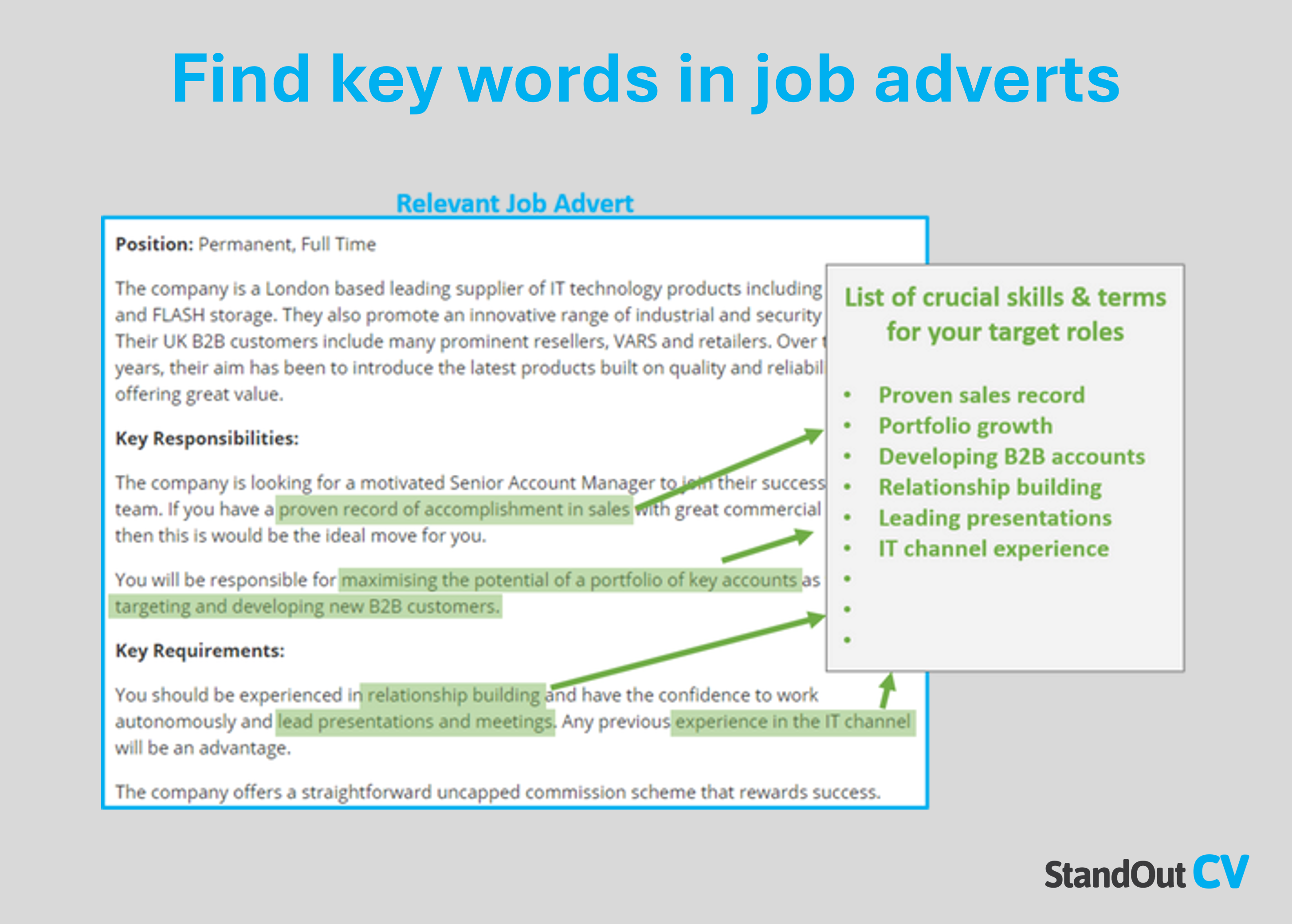
Focus mainly on hard skills such as languages, IT systems, industry experience etc.
Don’t focus on personal skills (such as adaptability, teamwork etc,) as they are needed for most jobs and won’t make you stand out.
Once you know what the recruiter wants from a successful candidate, try to reflect those attributes when writing the below points.
Industry skills
If you’re an experienced candidate, employers will mainly be interested in the work you have done in your industry, tools you are familiar with, type of projects you have worked on etc. so make these a focal point of your cover letter.
If you are less experienced (like a graduate or school leaver) focus on adding transferable skills from your studies, that can be carried over to the workplace.
Length of experience
Recruiters will need to know how much experience you have.
- Are you a graduate?
- Senior with 15 years of experience?
Qualifications
If the role you are applying for requires certain qualifications, then it’s crucial to mention them in your cover letter.
However, if the job advert doesn’t ask for them, or you simply know qualifications aren’t important to perform the role – then you can leave them out.
What you are currently doing
Recruiters will want to know what your current situation is, so be sure to inform them.
- Are you currently working in a similar role?
- Have you just left school?
- Are you immediately available, or do you have to work notice?
Your motivation for applying
One question that recruiters will often ask when they receive an application is, “ why is this person applying for the role ?”
And you need to answer that question in your cover letter.
Your reasons for applying should be positive, and suggest that you are looking to make a firm commitment to the employer.
Do write: “After spending 2 years as senior manager at my current firm, I am looking to take a step up to manage a bigger team in a more specialist market”
Don’t write: “ I’ve recently been fired from my old job, so I need a new one quickly”
Results you’ve achieved for employers
If you’re an experienced candidate, it’s a good idea to allude to the kind of results you have achieved for your current or previous employers.
Maybe you have;
- Saved them money
- Brought on new customers
- Improved processes
- Made plenty of sales
Only give an overview in your cover letter to keep things brief – save the detail for your CV .
How to end a cover letter
To end a cover letter , you should do 2 things; provide a strong call-to-action, and sign of professionally.
Provide a strong call to action
What is a call to action?
It’s simply a request to the reader to take a specific action…
In the case of your cover letter, the action you want the recruiter to take is open your CV.
So it can be helpful to write a line like,
“Please find my CV attached” near the bottom of your cover letter, to encourage readers to do so.
Sign off professionally
Finish your cover letter with a friendly term such as, “kind regards” followed by your name.
Then add a professional signature to the bottom, like the one below;

This makes the cover letter look professional and ensures that recruiters have;
- Your full name
- Phone number
- Email address
Cover letter samples
To give you some ideas and inspiration for writing your cover letter, here are 6 example cover letters .
Customer service cover letter

This customer service cover letter is short and to-the-point – it quickly delivers a host of reasons why this candidate would be valuable in a customer service role.
See also: sales assistant cover letter example
Finance cover letter
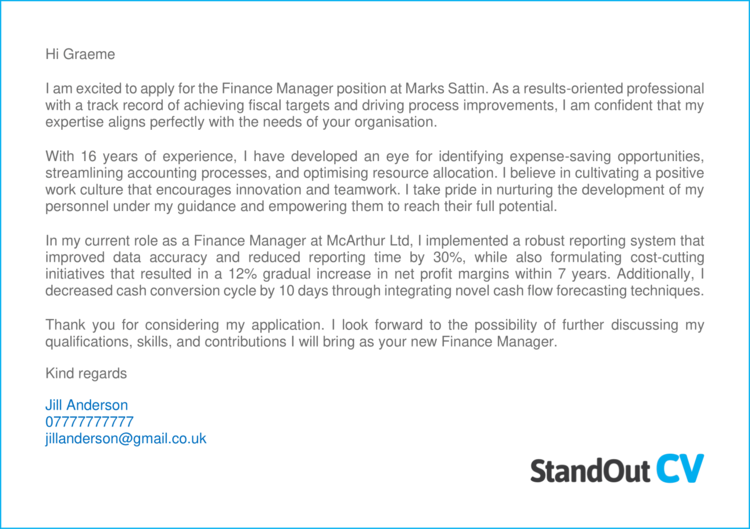
This cover letter outlines the candidate’s finance knowledge, and how they could apply it in the workplace
Graduate cover letter
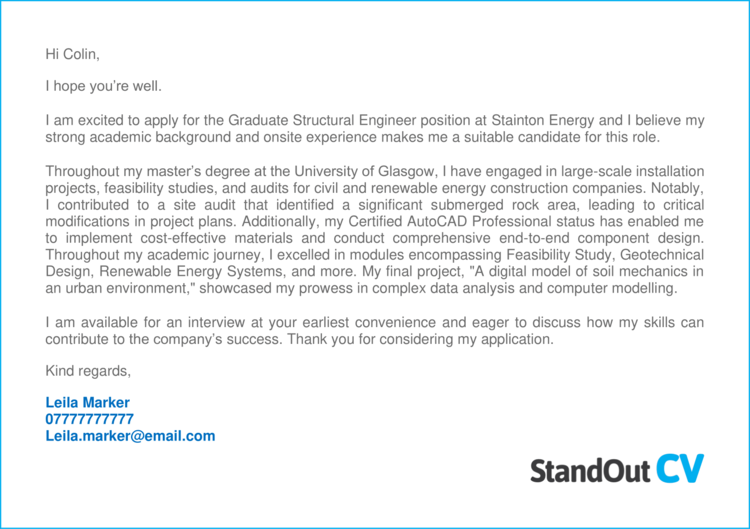
Graduate’s cover letters are a little longer than most, as they don’t have as much experience, so need to describe their education and transferable skills.
Sales cover letter
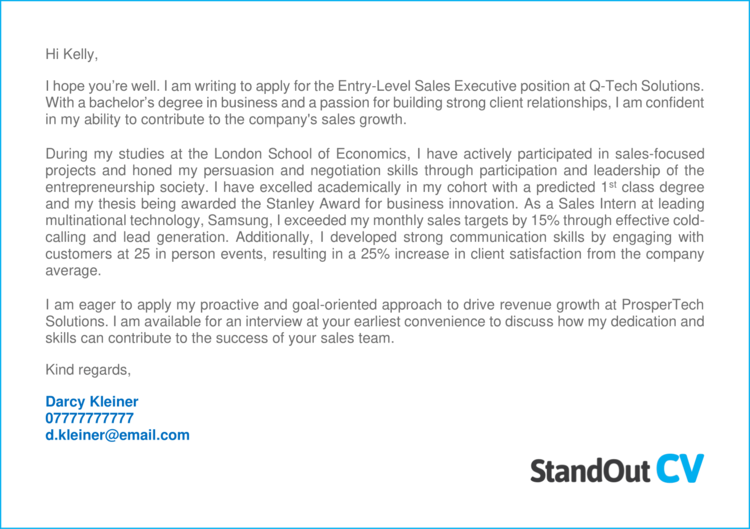
This cover letter boasts the candidate’s ability to make sales and drive revenue.
Project management cover letter
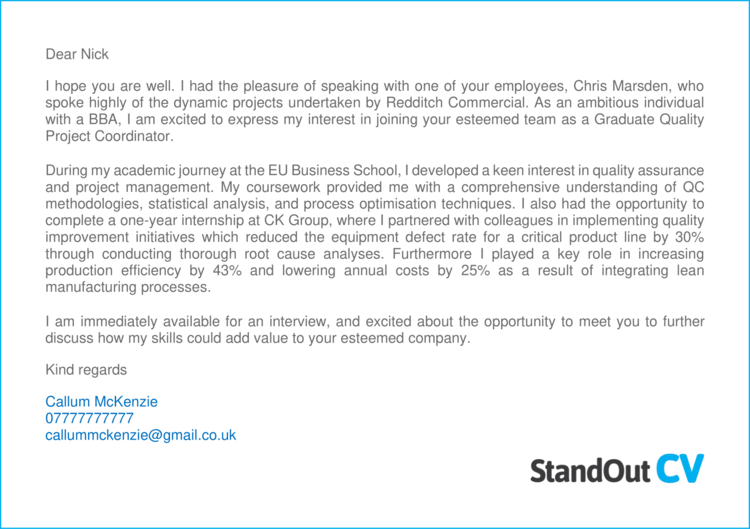
An overview of the candidate’s project manager skills and the types of projects they deliver, are enough to entice recruiters here.
Teacher cover letter
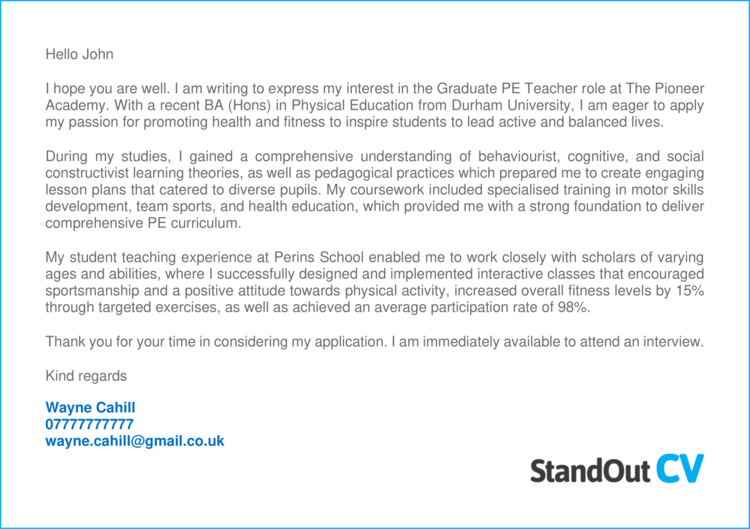
This teacher cover letter provides a brief synopsis of the candidate’s teaching abilities and the types of lessons they teach.
Cover letter mistakes
When writing your cover letter, be sure to avoid some of these common mistakes…
Don’t attach your cover letter as a separate document
You want the contents of your cover letter to instantly greet and connect with the recruiter opening it – so attaching it as separate document will slow that process down.
It doesn’t make sense to attach it as a separate document when you can write in the body of your email or message.
Don’t write a whole side of A4
Your cover letter should be a brief introduction and overview of your suitability for the job.
If you write too much, you risk boring the reader and they might skip past your application.
Save the in-depth details for your CV.
Don’t copy and paste the same cover letter
When your applying for lots of jobs, it can be tempting to simply copy and paste your cover letter into every application.
Whilst this will save you time, it will have a negative effect on your applications.
If you don’t take the time to tailor your cover letter for every job, it’s likely that you will miss some of the key requirements for each job, and therefore you will not make as good as impression as you could have.
It’s OK to work from a template, to keep the structure and some important points that you might repeat for most applications – but always tailor each cover letter to the job spec, for best results.
Don’t use “Dear sir or Madam”
This greeting many have worked well in the 1800’s, but it’s dated and impersonal now.
A simple “Hi” is a friendly and professional way to start your cover letter nowadays.
How to write a cover letter – conclusion
Your cover letter is a crucial tool in the quest to land interviews in the job market.
If you follow the advice above, you should be able to create a concise and powerful cover letter that will excite recruiters, and take you one step closer to landing that dream job
Good luck with your job search!
- Search Search Please fill out this field.
- Career Planning
- Finding a Job
How To Write a Cover Letter for a CV (With Examples)
:max_bytes(150000):strip_icc():format(webp)/ADHeadshot-Cropped-b80e40469d5b4852a68f94ad69d6e8bd.jpg)
Tips for Writing a Cover Letter for a CV
Proofread before sending, cover letter template, cover letter sample, sending an email cover letter, more cover letter examples.
When you apply for a job with a curriculum vitae (CV), it's important to include a cover letter, also known as a covering letter. This letter allows you to make a favorable first impression, using narrative in your own tone of voice to catch the reader’s attention and encourage them to seriously review your attached CV.
Like a resume, a CV summarizes your skills and experience. The difference between a CV and a resume is length, the focus on credentials, and what the documents are used for. Typically, a CV is required to apply for roles in academia, scientific research, and medical fields.
While your CV provides a detailed—and often lengthy—look at your experience and credentials, the cover letter is an opportunity to call out your most important qualifications and make a compelling case for your candidacy for the role at hand. Here's what you need to know to write a successful curriculum vitae cover letter.
Tailor the Letter to Fit the Organization
The CV cover letter should be tailored to respond to the unique and specific requirements requested by each organization you are approaching.
Do not use the same cover letter for every job you apply to, even though it may seem like a timesaver.
Each letter needs to provide detailed information about why are you are qualified for the specific job in question, and it should outline the reasons for your interest in the company or organization. Being specific is advantageous. Even if you're applying for two similar roles in two different hospitals, the two hospitals may serve different populations or require slightly different responsibilities for people in the role. Your letters to each hospital should reflect that.
Use your cover letter to identify the skills or experiences most specific to the job, rather than copying directly the information in your CV.
What to Include
As a candidate, it's tempting to feel like the cover letter is unnecessary, since it is likely that all the pertinent information is included in your CV. Still, as you can see, the cover letter is a helpful tool in your application. Here's what to keep in mind as you write a cover letter.
Format Matters
The content of your cover letter should be brief and structured. Aim for 3-5 paragraphs in your letter. Start with a salutation. Your letter should address the relevant contact, whose name often appears in the job advertisement. Avoid “Sir” or “Madam” if possible.
If the letter recipient's name isn't provided, try these tips to determine the correct contact person .
Start With an Introduction
Typically, the first paragraph will be an introduction—if you are applying to a job ad, mention it here. Mention the job title, any reference number, and where and when you saw it. The first paragraph is also where you should mention if someone referred you to the position.
The Body of the Cover Letter
The body of the letter—the second and third paragraphs—should highlight your relevant skills and experience. Highlight your transferable skills , achievements, and versatility. Explain what you can contribute and what makes you stand out from your competition. Include mention of your current or last job, qualifications, and professional and academic training, tailoring your information to make it as relevant as possible to the organization or job applied for.
In the body of the cover letter, you can mention personality traits relevant to the role at hand. You can also use this space to call out why you're interested in this specific role, at this specific company. Potential employers and hiring managers will appreciate it if you can show you've read the job ad and researched the company.
Avoid lengthy repetition of information covered in your CV. Unlike a CV, it is acceptable to write a cover letter in the first person.
Conclude the letter by succinctly summarizing why an employer may want to meet and employ you. Include a polite expression of interest in further dialogue with the recruiter. Do mention that you would like the opportunity to discuss your suitability further in a personal interview and that you await a response in due course.
Follow Instructions
In some cases, an advertisement will indicate that a more substantial letter is required.
Always follow specific instructions and include any information if it is specifically requested. For instance, some employers may ask you to include your current salary or your desired salary range.
Make Sure the Letter Reads Well
Ensure that your CV cover letter flows freely. You do not need to precisely match every point on the job description. The reader should be left with an overall impression that you are a potentially valuable addition to the workforce.
The letter should be readable and engaging.
Negative information of any sort should be avoided in your cover letter, as well as on your CV.
You'll want to be sure your letter is free from grammar or spelling errors. It should also be clearly presented—that means using standard formatting, and common readable fonts (such as Times New Roman or Verdana) in an appropriate size.
This is a cover letter example. Download the cover letter template (compatible with Google Docs and Word Online) or see below for more examples.
Depending on the employer's submission requirements, cover letters can be submitted online with your CV, uploaded online, or mailed. Be sure to follow the application instructions and follow the directions on how to apply. Consider this template for how to structure your letter:
Belinda Applicant 123 Main Street Anytown, CA 12345 555-555-5555 belinda.applicant@gmail.com
October 25, 2021
Clark Lee, PhD Biology Department Chair Northwestern University 123 Business Rd. Business City, NY 54321
Dear Dr, Lee:
I am writing to apply for the position of assistant professor in the Biology department, as described in the Northern University website. The opportunity to teach biology appeals to me, and I believe I can be an asset to the department due to my experience as a field biologist, as well as my work as an adjunct professor at Southern State University. In accordance with your job description, I have the following skills:
• Experience lecturing to large audiences
• Experience with learning management systems and course design
• Ability to assist with labs for other professors
• Experience with grant writing and research
I have enclosed my curriculum vitae so you may examine my work and research experience, the papers I’ve published, and my educational background.
I can be reached anytime by email at Belinda.applicant@gmail.com or my cell phone, 555-555-5555. Thank you so much for your time and consideration. I look forward to speaking with you about this position.
Signature (hard copy letter)
Belinda Applicant
When you are sending your cover letter by email, list your contact information in your signature rather than at the top of the letter. List your name and the job title in the subject line of the message.
Here are more examples of cover letters that you can use as a starting point for your own correspondence.

Contribute to the Microsoft 365 and Office forum! Click here to learn more 💡
April 9, 2024
Contribute to the Microsoft 365 and Office forum!
Click here to learn more 💡
Word Forum Top Contributors: Stefan Blom - Charles Kenyon - Doug Robbins - MVP Office Apps & Services (Word) - Suzanne S. Barnhill - Bob Jones AKA: CyberTaz ✅
May 10, 2024
Word Forum Top Contributors:
Stefan Blom - Charles Kenyon - Doug Robbins - MVP Office Apps & Services (Word) - Suzanne S. Barnhill - Bob Jones AKA: CyberTaz ✅
- Search the community and support articles
- Microsoft 365 and Office
- Search Community member
Ask a new question
How do I upload a cover letter and resume as one document?
Report abuse.
Reported content has been submitted
- Volunteer Moderator |
- Article Author
You can save your résumé in PDF format (Word offers a PDF option in the Save As dialog) and then use a split/merge application to combine your various PDFs. (An example of PDF split/merge applications is Gios PDF Splitter and Merger; see http://www.paologios.com/products/?type=bin .)
Text documents, in this context, is probably referring to plain text documents, the ones that NotePad can open.
Stefan Blom Microsoft Word MVP
13 people found this reply helpful
Was this reply helpful? Yes No
Sorry this didn't help.
Great! Thanks for your feedback.
How satisfied are you with this reply?
Thanks for your feedback, it helps us improve the site.
Thanks for your feedback.
Open the 2 doc files
<CTL A> to select all text in one document, the <CTL C> to copy it
go to second document
<CTL END> to jump to the end of the doc
<CTL V> to paste the copied document
you now have 2 of the documents in one.
save as the combined document to a new name as a "DOC" format file
move the cursor to the place you want to put the PDF file
Insert tab / Text group / Object ddl / select Object to display Object dialog / Create from File tab / browse to locate your PDF file (do NOT click on Link to File)
it will take a little time, but a PDF icon will eventually display in your document. The pdf is now embedded in the doc file. If the file name is not readable, type the file name in beside the icon and maybe include instruction something like this "Double click the icon to open this file"
You now have all three files in one, saved as a DOC format file.
43 people found this reply helpful
Replies (2)
Question info.
- Norsk Bokmål
- Ελληνικά
- Русский
- עברית
- العربية
- ไทย
- 한국어
- 中文(简体)
- 中文(繁體)
- 日本語
Money Report

Did ChatGPT write your resume and cover letter?: How to answer the most obvious job interview AI question
By emily larcher,cnbc • published may 16, 2024 • updated on may 16, 2024 at 12:30 pm.
- Studies show that a significant number, though by no means a majority, of job hunters are using artificial intelligence like ChatGPT to write resumes and cover letters.
- The use of gen AI in the job hunt is especially prevalent among younger workers.
- AI can be a valuable writing partner, but job seekers will need to be prepared to explain how and why they used it in the job application process.
Recent surveys show that artificial intelligence is playing a greater role in the job application process. Use of generative AI tools like ChatGPT is becoming more common as a writing partner for resumes and cover letters.
Free 24/7 Connecticut news stream: Watch NBC CT wherever you are
It's no surprise. It may be a good idea. Submitting materials as part of the job application process is a task that can cause anxiety and which people have an inclination to put off. Many job seekers fear their resume may not stand out from the crowd, or may include embarrassing errors that even after proofreading they somehow missed in a rush to apply. AI can ease some of these concerns and be a productive writing partner.
So far, the surveys suggest that roughly one-fifth of job seekers are relying on AI. A survey out this week from ResumeTemplates found that 22% of Gen Z job applicants used ChatGPT to create a resume or cover letter. An earlier survey conducted by ResumeBuilder found that in the past year, 18% of U.S. job seekers say that they used ChatGPT to craft resumes and cover letters, as well as prepare for interviews. In its survey, usage dips to 9% among job seekers in the 45 to 54 year-old age bracket.
Get Connecticut local news, weather forecasts and entertainment stories to your inbox. Sign up for NBC Connecticut newsletters.
Use of AI to write resumes and cover letters remains controversial. Some career experts say the big problem is that job seekers are using tools like ChatGPT the wrong way. As a hiring manager and founder of a career development business recently told CNBC Make It , "no matter how exciting this new technology is, humans are still in charge of the hiring process. Which is why having a robot write your resume is a recipe for disaster."
There is a risk that use of ChatGPT and similar tools leads to the production of resumes and cover letters that all start to look exactly the same .

Cramer reviews GigaCloud, dubs the company's story ‘unnecessarily fraught'

Cramer's Lighting Round: Abercrombie & Fitch is a buy
Importantly, the ResumeTemplates survey found that 77% of job seekers who used AI said they made edits to what ChatGPT provided.
In the end, the situation is similar to what's happening in education. Banning use of ChatGPT and other gen AI among students is a losing battle for teachers. Better to help students understand how to use AI as a tutoring tool to improve their own unique performance. Editing a first draft of a resume or cover letter produced by an AI — the same way that a student might an essay — is an important step. But even if a job seeker is successful in creating a resume or cover letter with an AI that stands out, that still won't prepare them for the final step: when human resources or a hiring manager asks them point blank whether they used AI in the job application process.
Here's how career experts say you should handle that.
Career expert advice on using AI to get hired
ChatGPT can in fact help you land a job, according to those who have used it. The first thing to know is that fear that hiring firms will look down upon use of AI is not a given, by any stretch. The recent ResumeBuilder survey found that over half (55%) of job seekers stated that potential employers lauded their use of AI during job interviews. Only 29% of job seekers said they believed their use of AI with prospective employers led them to not be hired.
Any job interview question about AI should be seen as a chance to pivot the conversation. When HR or a hiring manager asks about use of AI in production of a cover letter or resume, the onus is on the job seeker to pivot the AI conversation to make a more compelling point, says Marissa Morrison, v.p. of people at ZipRecruiter. Applicants should have a talking point prepared to show that their use of AI is an example of their familiarity with, and embrace of, technology trends. Morrison said job seekers that are open about their AI use for "administrative and automated tasks" can demonstrate they are prepared to create new avenues of productivity on the job — a key goal of organizations in AI adoption.
Don't deny use of AI, and be knowledgeable about how a hiring firm uses it. Vicki Salemi, career expert for Monster.com, says job seekers should start with honesty — denying the use of AI won't get you anywhere. She also focused on how to pivot the AI conversation. Specifically, ahead of any interview, job seekers should research and be knowledgeable about a specific company's scope of AI use, and bring an AI conversation with HR or hiring managers back to that company-specific case.
Be skeptical of working for any company that is dismissive of AI . Job seekers should be on the lookout for companies that may be a bad fit — any organization that is dismissive of AI may not be where a worker wants to grow in a career long-term. Julia Toothacre, resume and career strategist for ResumeBuilder, said no matter how much a job seeker may need a position, this is not a red flag to be ignored given where most of the market is going with AI deployment. As with the other experts, Toothacre says job seekers should practice talking about how they not only embrace, but "own" AI and are prepared to leverage it in "understanding job efficiency standards."
Most important of all: Never use AI as a "crutch." What ChatGPT, or any other AI tool, should not be is a "crutch" to generate resumes and cover letters tailored to job postings, says Katie McGinnis, vice president of human resources at online learning company Udacity. Employers can easily spot when an applicant relied solely on AI for resumes and cover letters. McGinnis says to be as specific as possible during job interviews about AI skills, "just as you would any other technical skills."
Also on CNBC
- Paid time off for pregnant women could become national movement, led by New York
- Warren Buffett says one AI question has stumped economists for a century
- How Deere is preparing for a fully autonomous farm by 2030

This article tagged under:

How to Write a Cover Letter That Will Get You a Job
I ’ve read thousands, maybe tens of thousands, of cover letters in my career. If you’re thinking that sounds like really boring reading, you’re right. What I can tell you from enduring that experience is that most cover letters are terrible — and not only that, but squandered opportunities. When a cover letter is done well, it can significantly increase your chances of getting an interview, but the vast majority fail that test.
So let’s talk about how to do cover letters right.
First, understand the point of a cover letter.
The whole idea of a cover letter is that it can help the employer see you as more than just your résumé. Managers generally aren’t hiring based solely on your work history; your experience is crucial, yes, but they’re also looking for someone who will be easy to work with, shows good judgment, communicates well, possesses strong critical thinking skills and a drive to get things done, complements their current team, and all the other things you yourself probably want from your co-workers. It’s tough to learn much about those things from job history alone, and that’s where your cover letter comes in.
Because of that …
Whatever you do, don’t just summarize your résumé.
The No. 1 mistake people make with cover letters is that they simply use them to summarize their résumé. This makes no sense — hiring managers don’t need a summary of your résumé! It’s on the very next page! They’re about to see it as soon as they scroll down. And if you think about it, your entire application is only a few pages (in most cases, a one- or two-page résumé and a one-page cover letter) — why would you squander one of those pages by repeating the content of the others? And yet, probably 95 percent of the cover letters I see don’t add anything new beyond the résumé itself (and that’s a conservative estimate).
Instead, your cover letter should go beyond your work history to talk about things that make you especially well-suited for the job. For example, if you’re applying for an assistant job that requires being highly organized and you neurotically track your household finances in a detailed, color-coded spreadsheet, most hiring managers would love to know that because it says something about the kind of attention to detail you’d bring to the job. That’s not something you could put on your résumé, but it can go in your cover letter.
Or maybe your last boss told you that you were the most accurate data processor she’d ever seen, or came to rely on you as her go-to person whenever a lightning-fast rewrite was needed. Maybe your co-workers called you “the client whisperer” because of your skill in calming upset clients. Maybe you’re regularly sought out by more senior staff to help problem-solve, or you find immense satisfaction in bringing order to chaos. Those sorts of details illustrate what you bring to the job in a different way than your résumé does, and they belong in your cover letter.
If you’re still stumped, pretend you’re writing an email to a friend about why you’d be great at the job. You probably wouldn’t do that by stiffly reciting your work history, right? You’d talk about what you’re good at and how you’d approach the work. That’s what you want here.
You don’t need a creative opening line.
If you think you need to open the letter with something creative or catchy, I am here to tell you that you don’t. Just be simple and straightforward:
• “I’m writing to apply for your X position.”
• “I’d love to be considered for your X position.”
• “I’m interested in your X position because …”
• “I’m excited to apply for your X position.”
That’s it! Straightforward is fine — better, even, if the alternative is sounding like an aggressive salesperson.
Show, don’t tell.
A lot of cover letters assert that the person who wrote it would excel at the job or announce that the applicant is a skillful engineer or a great communicator or all sorts of other subjective superlatives. That’s wasted space — the hiring manager has no reason to believe it, and so many candidates claim those things about themselves that most managers ignore that sort of self-assessment entirely. So instead of simply declaring that you’re great at X (whatever X is), your letter should demonstrate that. And the way you do that is by describing accomplishments and experiences that illustrate it.
Here’s a concrete example taken from one extraordinarily effective cover-letter makeover that I saw. The candidate had originally written, “I offer exceptional attention to detail, highly developed communication skills, and a talent for managing complex projects with a demonstrated ability to prioritize and multitask.” That’s pretty boring and not especially convincing, right? (This is also exactly how most people’s cover letters read.)
In her revised version, she wrote this instead:
“In addition to being flexible and responsive, I’m also a fanatic for details — particularly when it comes to presentation. One of my recent projects involved coordinating a 200-page grant proposal: I proofed and edited the narratives provided by the division head, formatted spreadsheets, and generally made sure that every line was letter-perfect and that the entire finished product conformed to the specific guidelines of the RFP. (The result? A five-year, $1.5 million grant award.) I believe in applying this same level of attention to detail to tasks as visible as prepping the materials for a top-level meeting and as mundane as making sure the copier never runs out of paper.”
That second version is so much more compelling and interesting — and makes me believe that she really is great with details.
If there’s anything unusual or confusing about your candidacy, address it in the letter.
Your cover letter is your chance to provide context for things that otherwise might seem confusing or less than ideal to a hiring manager. For example, if you’re overqualified for the position but are excited about it anyway, or if you’re a bit underqualified but have reason to think you could excel at the job, address that up front. Or if your background is in a different field but you’re actively working to move into this one, say so, talk about why, and explain how your experience will translate. Or if you’re applying for a job across the country from where you live because you’re hoping to relocate to be closer to your family, let them know that.
If you don’t provide that kind of context, it’s too easy for a hiring manager to decide you’re the wrong fit or applying to everything you see or don’t understand the job description and put you in the “no” pile. A cover letter gives you a chance to say, “No, wait — here’s why this could be a good match.”
Keep the tone warm and conversational.
While there are some industries that prize formal-sounding cover letters — like law — in most fields, yours will stand out if it’s warm and conversational. Aim for the tone you’d use if you were writing to a co-worker whom you liked a lot but didn’t know especially well. It’s okay to show some personality or even use humor; as long as you don’t go overboard, your letter will be stronger for it.
Don’t use a form letter.
You don’t need to write every cover letter completely from scratch, but if you’re not customizing it to each job, you’re doing it wrong. Form letters tend to read like form letters, and they waste the chance to speak to the specifics of what this employer is looking for and what it will take to thrive in this particular job.
If you’re applying for a lot of similar jobs, of course you’ll end up reusing language from one letter to the next. But you shouldn’t have a single cover letter that you wrote once and then use every time you apply; whatever you send should sound like you wrote it with the nuances of this one job in mind.
A good litmus test is this: Could you imagine other applicants for this job sending in the same letter? If so, that’s a sign that you haven’t made it individualized enough to you and are probably leaning too heavily on reciting your work history.
No, you don’t need to hunt down the hiring manager’s name.
If you read much job-search advice, at some point you’ll come across the idea that you need to do Woodward and Bernstein–level research to hunt down the hiring manager’s name in order to open your letter with “Dear Matilda Jones.” You don’t need to do this; no reasonable hiring manager will care. If the name is easily available, by all means, feel free to use it, but otherwise “Dear Hiring Manager” is absolutely fine. Take the hour you just freed up and do something more enjoyable with it.
Keep it under one page.
If your cover letters are longer than a page, you’re writing too much, and you risk annoying hiring managers who are likely sifting through hundreds of applications and don’t have time to read lengthy tomes. On the other hand, if you only write one paragraph, it’s unlikely that you’re making a compelling case for yourself as a candidate — not impossible, but unlikely. For most people, something close to a page is about right.
Don’t agonize over the small details.
What matters most about your cover letter is its content. You should of course ensure that it’s well-written and thoroughly proofread, but many job seekers agonize over elements of the letter that really don’t matter. I get tons of questions from job seekers about whether they should attach their cover letter or put it in the body of the email (answer: No one cares, but attaching it makes it easier to share and will preserve your formatting), or what to name the file (again, no one really cares as long as it’s reasonably professional, but when people are dealing with hundreds of files named “resume,” it’s courteous to name it with your full name).
Approaching your cover letter like this can make a huge difference in your job search. It can be the thing that moves your application from the “maybe” pile (or even the “no” pile) to the “yes” pile. Of course, writing cover letters like this will take more time than sending out the same templated letter summarizing your résumé — but 10 personalized, compelling cover letters are likely to get you more interview invitations than 50 generic ones will.
- ‘I Had a Great Job Interview — Why Haven’t I Heard Back?’
- How to Answer ‘Tell Me About Yourself’ in a Job Interview


COMMENTS
3. Open a new document. To begin combining your resume and cover letter into a single document, start a new file on your computer in your preferred application or platform. Choose a file name that's professional and use your full name without any numbers to differentiate your application from the candidate pool.
Click on Insert > Attach File. Your email client will display a list of files in the default file folder of your computer. If your resume and cover letter are stored in a different folder, click on the appropriate folder. Click to select the file you want to add to your email message, and then click on Insert to attach the document to your ...
5. Attach your cover letter to the email correctly. To attach a file to an email, start by creating a new email message in your email program. Next, select the paperclip icon in the toolbar part of the email box. This will take you to your device's quick access ribbon, where you can select your cover letter from the appropriate file folder ...
1. Include the cover letter as an attached file. If you decide to attach your cover letter separately to the email, always write a short message in the body of the email introducing yourself and giving the reason for emailing the recruiter - don't leave it blank! The content of your email body should be short, informative and to the point:
There are two email formats which you can use to include your cover letter. You can either copy and paste it into the main body of the email, or include it as a PDF or Word document. If you send the resume cover email as an attachment, you still need to write an email for attaching the resume. Write a formal email stating why you are applying ...
Write a clear and professional subject line that includes the job title and your name. Compose a brief message in the body of the email, introducing yourself and stating the position you are applying for. Attach your cover letter and resume to the email, making sure they are properly named and labeled.
Use a page break to keep the cover letter on page 1 and the resume on page 2. Afterwards, browse for the combined document on the hard drive and upload it to the employer's website. Many online applications will display some type of status message, such as "Upload Complete" or "Upload Successful." Many recruiters don't even bother to read cover ...
CV templates How to layout a cover letter for your CV. This annotated example of a cover letter shows you how you should structure your cover letters, and the type of information you should be including.. You should always write your CV in the body of your email (or job site messaging system) so that it can be read instantly. Never attach it as a separate document, or the recipient probably ...
How to write a CV cover letter. You can use the following process to write an effective CV cover letter: 1. Identify the requirements for the position. Read the job description well and identify employer expectations in relation to academic achievements, education, skills, and experience. Make a list of these expectations.
start your cover letter. with your contact details at the top. These should be in your cover letter's header, separated neatly from the bulk of your text. Here, you want to include all the essential contact information, including: Full Name. Your first and last name should stand out at the top. Job Title.
Inform the recipient that your cover letter and resume are attached as requested. 3. Type the letter into the body of the email message if the employer does not ask you to attach it as a document. Write a brief yet professional one- to two-paragraph letter indicating your interest. Highlight one or two skills that make you ideal for the position.
Sign off professionally. Finish your cover letter with a friendly term such as, "kind regards" followed by your name. Then add a professional signature to the bottom, like the one below; This makes the cover letter look professional and ensures that recruiters have; Your full name. Phone number. Email address.
Cover Letter Sample. Sending an Email Cover Letter. More Cover Letter Examples. Photo: Wutthichai Luemuang / EyeEm / Getty Images. A cover letter should be included with every curriculum vitae you send. Learn about what to include in a cover letter for a CV and review some examples.
Cover letter paragraph 1: The introduction. The position you are interested in and why you are applying for it - a brief introductory passage that covers three things: Why you're writing the letter. What job role you are applying for. How you found out about the job. Something like:
Open the 2 doc files. <CTL A> to select all text in one document, the <CTL C> to copy it. go to second document. <CTL END> to jump to the end of the doc. <CTL V> to paste the copied document. you now have 2 of the documents in one. save as the combined document to a new name as a "DOC" format file.
Throughout this guide, we're going to give you the tools you need to create cover letters and resumes that get results, tips that will help you ace your interviews, and information on what to do after the interview to help you land the job! Proven strategies for what to include in cover letters. Formatting for various resume styles and types.
As with all legal writing, make sure you draft early and revise frequently. Draft your resume and cover letter as soon as you learn of an opportunity in which you are interested. Then, set it aside for a short period and come back to revise it with fresh eyes. This will help you spot weaknesses in your drafting and notice typos you missed on ...
Let's review four key pieces of information you can weave into your career change cover letter. 1. Clarify your career change context. Explaining why you're interested in changing careers and how the role you're applying to fits within your larger career aspirations can preemptively contextualize your story.
Decide on a CV format and style. Before you start writing your CV, you need to format it properly. Open a new document in Microsoft Word or Google Docs and use the following settings: Set ½ - 1" margins on each side. Use a font size between 10 and 12 points. Select a professional font such as Times New Roman or Arial.
When HR or a hiring manager asks about use of AI in production of a cover letter or resume, the onus is on the job seeker to pivot the AI conversation to make a more compelling point, says Marissa ...
If you think you need to open the letter with something creative or catchy, I am here to tell you that you don't. Just be simple and straightforward: • "I'm writing to apply for your X ...
The section-specific tips and examples below will show you how to create and format a strong resume in Google Docs. 1. Add a dynamic profile summarizing your qualifications. ... Expert advice: include a cover letter with your resume. To increase your chances of an interview, write and submit a strong cover letter. The Google Docs template ...